My Two Cents
One of the unintended consequences of living abroad is being confronted by one's identity. At least from my experience, whether I like it or I like it very much, I will be asked about where I am from, what my country of origin is like, and the way people of my supposedly own keen live. From such experience that I got a feeling everyone unconsciously becomes an ambassador of one's country of origin when abroad. At this point, you ought to bring your counter-arguments in the discussion board below. Now, I like answering questions about the Philippines. But if and when I encounter non-Filipinos who have been to one of the 7,107 islands themselves, they are always first to acknowledge the country's paradisiac beauty. They gush and all I have to do is smile and nod aggressively in fervor agreement. Relax, my neck is fine, it doesn't happen too often enough unfortunately.Another unintended consequence of living abroad is arriving at a conscious effort to unearth, look for, search, enrich, strengthen, compose one's authentic identity.The process never ends. But at least for now I can say that part of adaptation when one lives as a foreigner is to blend in without deliberately forgetting one's original flavor. Then being different becomes less of a hindrance and even works to one's advantage when integrating (i.e. makes one more interesting). Blending in requires careful observation, lots of it. It's no easy task and if one lacks determination, forgetting one's origin is most likely its collateral damage. On the other side of the spectrum, a new environment is as much revealing of one's own intolerance to blend in.
But I digress, as far as anybody's concerned, one does not live on origin alone. We all came from Africa if we truly get down to the bottom of it. Nonetheless, these consequences I do consider now as an opportunity, if not privileges, of living abroad.
The Philippine Exhibit
Exhibit A. Normally, I wouldn't travel to another country to solely visit a museum. But since a museum in Paris was showcasing pre-colonial Filipino artwork and artifacts on a limited time, off I went avec mon amour, Yoyo. Besides, Paris is a mere three-hour drive from Ghent, Belgium. Learning about myself through my ancestors + visiting the French capital = hitting two birds with one stone / faire d'une pierre deux coups / twee vliegen in een klap slaan (ooops, Belgian integration kicks in). 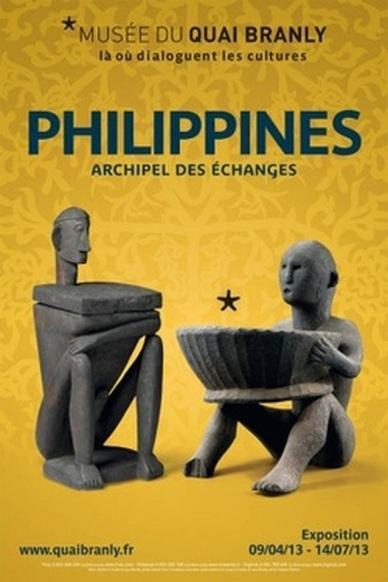 Philippines: An Archipelago of Exchange was held in the Garden Gallery of the Quai Branly Museum.
Philippines: An Archipelago of Exchange was held in the Garden Gallery of the Quai Branly Museum. 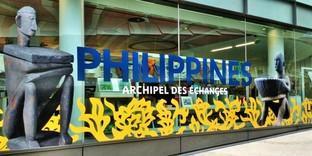
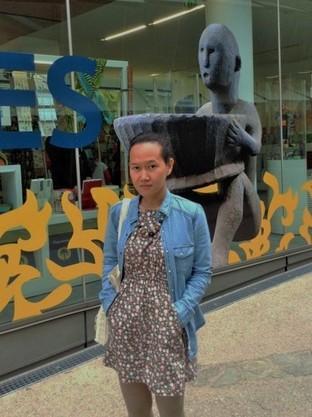 Top photo, decorated glass walls towards the entrance. Below, me posing infront, naturalement.
Top photo, decorated glass walls towards the entrance. Below, me posing infront, naturalement.
The exhibit entitled Philippine: Archipel des échange turned out to be the 'biggest and most substantial exhibition of precolonial Philippine artifacts ever assembled in the world, even in the Philippines' to date. It had three sections, namely: the traditional works of the northern highlands of Luzon; the textiles, costumes and ornaments of warriors from Mindanao; and the influence of the shipping network on the items produced by the southern coastal societies such as Palawan, Mindanao and Sulu. It opened on the 9th of April 2013 and lasted until July 14, 2013, a three-month showcase of selected indigenous art pieces and ethnographic items at the Musée du Quai Branly in Paris, France.
Musée du Quai Branly is one of Europe's premier museums visited by an average of 1.4 million people annually. Dedicated to the arts and civilizations of Africa, Asia, Oceania, and the Americas, it houses a collection of over 400,000 objects, 700,000 photographs 3,500 artworks, and 10,000 musical instruments on permanent display. It does not hurt one bit that the museum is located on the banks of the Seine River at the foot of the Eiffel Tower.
Photo Gallery
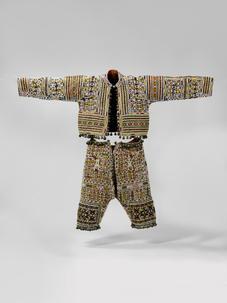 1. Ethnic dance productions have similar costumes in school and also in fiesta street dance parades!
1. Ethnic dance productions have similar costumes in school and also in fiesta street dance parades! 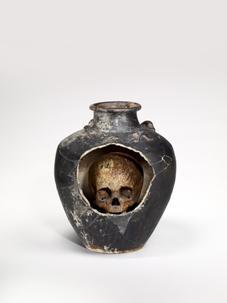 2. Reminds me of the real skull my brother, who was then in highschool, used to keep in his room. And we used to store drinking water in a similar jar in Daram. I kid you not.
2. Reminds me of the real skull my brother, who was then in highschool, used to keep in his room. And we used to store drinking water in a similar jar in Daram. I kid you not.  3. This type of bag abounds in the Bicol region of the Philippines where I frequented between years 2007-2009 for work.
3. This type of bag abounds in the Bicol region of the Philippines where I frequented between years 2007-2009 for work.
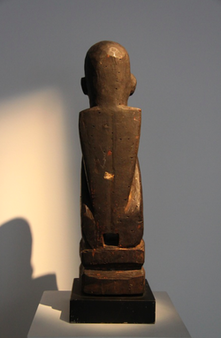 4. Ben Cab, a famous Filipino artist, has a roomful of Bululs, like this one.
4. Ben Cab, a famous Filipino artist, has a roomful of Bululs, like this one. 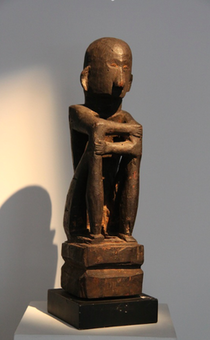 5. My cousin who studied Fine Arts in the north of Philippines made a bulul herself, like this one.
5. My cousin who studied Fine Arts in the north of Philippines made a bulul herself, like this one.
Case in point, the Filipino ancestral heritage and culture is alive and kicking. Hurray!
Additional References:
> Philippine Daily Inquirer (PDI) Article 1.
> PDI Article 2
> Photos 1,2,3.
> Photos 4,5 (Bulul).

